Items filtered by date: September 2025
Dry and Red Skin on the Feet Can Indicate Serious Foot Conditions
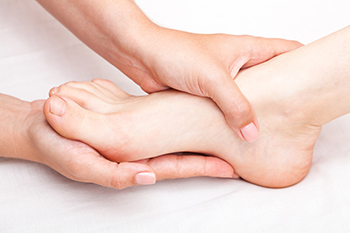
Research has shown the feet can indicate serious health issues within the body. The condition known as scleroderma may be evident in the feet. The symptoms can consist of cold feet and toes and can be associated with Raynaud’s phenomenon. Additional signs of scleroderma may include having patches of thickened skin that develop on the feet. The affected skin may be dry or itchy and will often require expert medical care. A chilblain may occur with Raynaud's disease and the skin may turn red, swollen, and become tender when touched. Having poor blood circulation and exposure to cold weather may lead to this condition, and it can affect the toes. There are simple methods that can be implemented to properly care for the feet. These can consist of choosing shoes that fit correctly and moisturizing the feet often. Many people who are affected by systemic sclerosis can experience a feeling of walking on small pebbles and this may be relieved by wearing custom-made orthotics. If you have any of these symptoms and would like to know more about systemic diseases of the feet, please confer with a podiatrist.
When dealing with systemic disease of the feet, it is extremely important to check the affected areas routinely so that any additional problems are caught quickly. If you have any concerns about your feet and ankles contact Ankita Patel, DPM from All Pro Foot and Ankle. Our doctor will assist you with all of your podiatric needs.
Systemic Diseases of the Feet
Systemic diseases affect the whole body, and symptoms usually are displayed in the feet. This condition can make a patient’s ability to walk unbearable. Systemic diseases include gout, diabetes mellitus, neurological disorders, and arthritis.
Gout – is caused by an excess of uric acid in the body. Common symptoms include pain, inflammation, and redness at the metatarsal/phalangeal joint of the base big toe. Gout can be treated by NSAIDs to relieve pain and inflammation, and other drugs that lower the acid levels in the body.
Diabetes mellitus – is an increase in the level of blood sugar that the body cannot counteract with its own insulin. Failure to produce enough insulin is a factor in Diabetes.
Diabetes of the Feet
Diabetic Neuropathy – may lead to damaged nerves and affect the feet through numbness and loss of sensation.
Peripheral Vascular Disease – can restrict the blood flow to the feet, and often times lead to amputation of the feet.
If you have any questions please contact our office located in Swedesboro, NJ . We offer the newest diagnostic and treatment technologies for all your foot and ankle needs.
What to Know About Ingrown Toenails
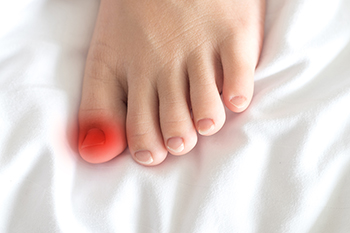
Ingrown toenails develop when the edge of a toenail grows into the surrounding skin, most often affecting the big toe. Common causes include cutting toenails too short, wearing tight or ill-fitting shoes, toe injuries, or having naturally curved nails. Symptoms include redness, swelling, tenderness, and pain along the nail margin. If left untreated, the area can become infected, leading to drainage, increased swelling, and more intense discomfort. The affected toe may feel warm to the touch and make walking or wearing shoes difficult. A podiatrist can diagnose an ingrown toenail through a visual examination and determine if an infection is present. Treatment options range from soaking the foot and gently lifting the nail to performing a minor procedure to remove part of the nail. In some cases, a more permanent solution may be recommended to prevent recurrence. It is suggested that you make an appointment with a podiatrist to relieve pain and avoid further complications.
Ingrown toenails may initially present themselves as a minor discomfort, but they may progress into an infection in the skin without proper treatment. For more information about ingrown toenails, contact Ankita Patel, DPM of All Pro Foot and Ankle. Our doctor can provide the care you need to keep you pain-free and on your feet.
Ingrown Toenails
Ingrown toenails are caused when the corner or side of a toenail grows into the soft flesh surrounding it. They often result in redness, swelling, pain, and in some cases, infection. This condition typically affects the big toe and may recur if it is not treated properly.
Causes
- Improper toenail trimming
- Genetics
- Improper shoe fitting
- Injury from pedicures or nail picking
- Abnormal gait
- Poor hygiene
You are more likely to develop an ingrown toenail if you are obese, have diabetes, arthritis, or have any fungal infection in your nails. Additionally, people who have foot or toe deformities are at a higher risk of developing an ingrown toenail.
Symptoms
Some symptoms of ingrown toenails are redness, swelling, and pain. In rare cases, there may be a yellowish drainage coming from the nail.
Treatment
Ignoring an ingrown toenail can have serious complications. Infections of the nail border can progress to a deeper soft-tissue infection, which can then turn into a bone infection. You should always speak with your podiatrist if you suspect you have an ingrown toenail, especially if you have diabetes or poor circulation.
If you have any questions, please feel free to contact our office located in Swedesboro, NJ . We offer the newest diagnostic and treatment technologies for all your foot care needs.
When Sudden Foot Pain Strikes
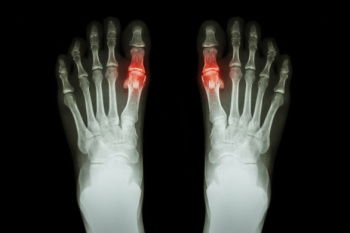
Gout is a form of inflammatory arthritis that often affects the feet, especially the big toe. It is caused by a buildup of uric acid in the blood, which forms sharp crystals in the joints. Common triggers include a diet high in purines, alcohol consumption, obesity, and certain medications or health conditions. Symptoms typically appear suddenly and may include intense pain, swelling, and warmth in the affected joint. The pain can be severe enough to wake someone from sleep, and may make walking or wearing shoes difficult. Visually, the joint may appear inflamed and extremely tender. A podiatrist can help diagnose gout through a physical examination, medical history, and possibly a fluid or blood test. Treatment options may include anti-inflammatory medications, dietary guidance, and long-term management strategies to prevent future flare-ups. A podiatrist can also help monitor joint health and manage ongoing discomfort. If you are dealing with gout, it is suggested that you schedule an appointment with a podiatrist to properly manage and treat this condition.
Gout is a foot condition that requires certain treatment and care. If you are seeking treatment, contact Ankita Patel, DPM from All Pro Foot and Ankle. Our doctor will treat your foot and ankle needs.
What Is Gout?
Gout is a type of arthritis caused by a buildup of uric acid in the bloodstream. It often develops in the foot, especially the big toe area, although it can manifest in other parts of the body as well. Gout can make walking and standing very painful and is especially common in diabetics and the obese.
People typically get gout because of a poor diet. Genetic predisposition is also a factor. The children of parents who have had gout frequently have a chance of developing it themselves.
Gout can easily be identified by redness and inflammation of the big toe and the surrounding areas of the foot. Other symptoms include extreme fatigue, joint pain, and running high fevers. Sometimes corticosteroid drugs can be prescribed to treat gout, but the best way to combat this disease is to get more exercise and eat a better diet.
If you have any questions, please feel free to contact our office located in Swedesboro, NJ . We offer the newest diagnostic and treatment technologies for all your foot care needs.
Inspect Your Feet Regularly for Abnormalities if You're Diabetic
When the Ball of Your Foot Hurts
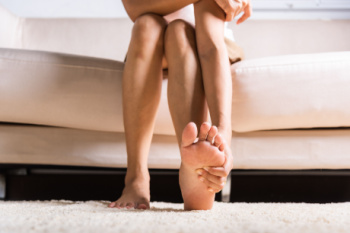
Pain in the ball of the foot occurs when the area between the toes and the long bones of the feet is placed under too much pressure. This part of the foot absorbs the impact of walking and running, so when the bones and joints located here do not line up properly, discomfort can follow. Conditions like arthritis can cause swelling and stiffness in these joints, while toe deformities such as hammer toes or bunions may increase strain. As people age, the natural fat pad that cushions the ball of the foot often becomes thinner, leaving less protection against pressure. Repetitive activities such as jogging, playing sports, or even long hours of standing can make the pain worse. Wearing shoes that lack adequate support, like high heels or flip-flops, may also add stress to this area. A podiatrist can examine the foot, prescribe custom orthotics to reduce pressure, and provide surgery, if needed. If you have pain in the ball of your foot, it is suggested that you schedule an appointment with a podiatrist for an exam and appropriate treatment.
Foot Pain
Foot pain can be extremely painful and debilitating. If you have a foot pain, consult with Ankita Patel, DPM from All Pro Foot and Ankle. Our doctor will assess your condition and provide you with quality foot and ankle treatment.
Causes
Foot pain is a very broad condition that could be caused by one or more ailments. The most common include:
- Bunions
- Hammertoes
- Plantar Fasciitis
- Bone Spurs
- Corns
- Tarsal Tunnel Syndrome
- Ingrown Toenails
- Arthritis (such as Gout, Rheumatoid, and Osteoarthritis)
- Flat Feet
- Injury (from stress fractures, broken toe, foot, ankle, Achilles tendon ruptures, and sprains)
- And more
Diagnosis
To figure out the cause of foot pain, podiatrists utilize several different methods. This can range from simple visual inspections and sensation tests to X-rays and MRI scans. Prior medical history, family medical history, and any recent physical traumatic events will all be taken into consideration for a proper diagnosis.
Treatment
Treatment depends upon the cause of the foot pain. Whether it is resting, staying off the foot, or having surgery; podiatrists have a number of treatment options available for foot pain.
If you have any questions, please feel free to contact our office located in Swedesboro, NJ . We offer the newest diagnostic and treatment technologies for all your foot care needs.
Why Women Are More Prone to Bunions
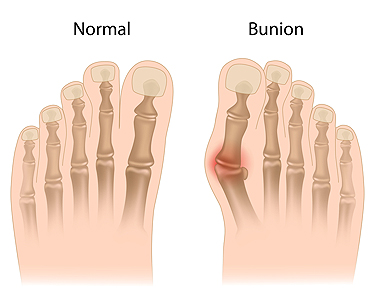
Bunions are bony bumps that form at the base of the big toe, and women are more likely to develop them due to footwear choices and genetic factors. Narrow or high-heeled shoes with a pointed toe box can place excess pressure on the front of the foot, leading to misalignment over time. Symptoms include pain, swelling, redness, and difficulty wearing certain shoes. Risk factors include a family history of bunions, flat feet, and conditions such as like arthritis. A podiatrist can provide relief through customized footwear advice, orthotics, and, when necessary, surgical correction. If you are experiencing discomfort from bunions, it is suggested that you visit a podiatrist who can offer effective relief and management tips.
If you are suffering from bunion pain, contact Ankita Patel, DPM of All Pro Foot and Ankle. Our doctor can provide the care you need to keep you pain-free and on your feet.
What Is a Bunion?
Bunions are painful bony bumps that usually develop on the inside of the foot at the joint of the big toe. As the deformity increases over time, it may become painful to walk and wear shoes. Women are more likely to exacerbate existing bunions since they often wear tight, narrow shoes that shift their toes together. Bunion pain can be relieved by wearing wider shoes with enough room for the toes.
Causes
- Genetics – some people inherit feet that are more prone to bunion development
- Inflammatory Conditions - rheumatoid arthritis and polio may cause bunion development
Symptoms
- Redness and inflammation
- Pain and tenderness
- Callus or corns on the bump
- Restricted motion in the big toe
In order to diagnose your bunion, your podiatrist may ask about your medical history, symptoms, and general health. Your doctor might also order an x-ray to take a closer look at your feet. Nonsurgical treatment options include orthotics, padding, icing, changes in footwear, and medication. If nonsurgical treatments don’t alleviate your bunion pain, surgery may be necessary.
If you have any questions, please feel free to contact our office located in Swedesboro, NJ . We offer the newest diagnostic and treatment technologies for all your foot care needs.

